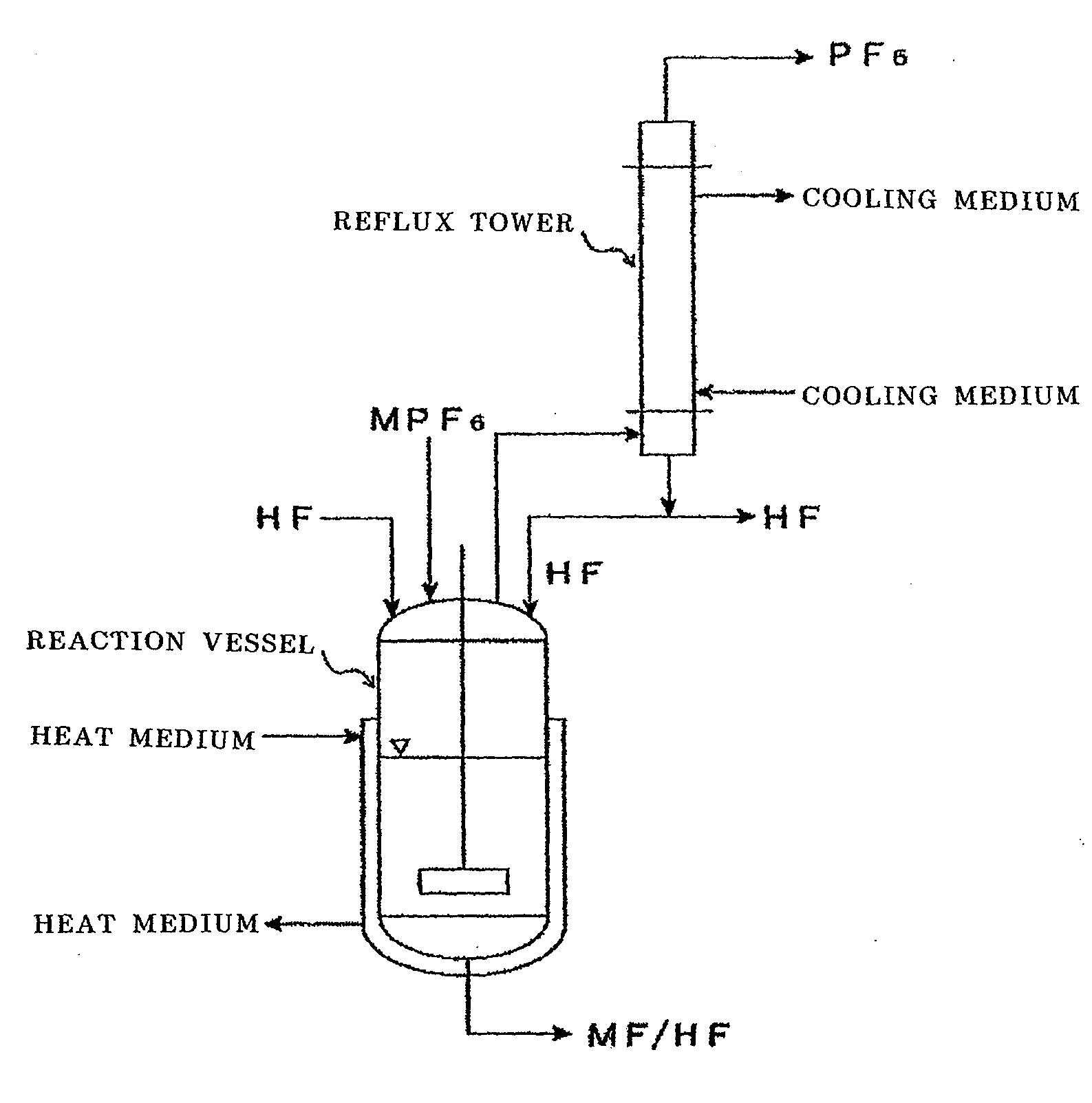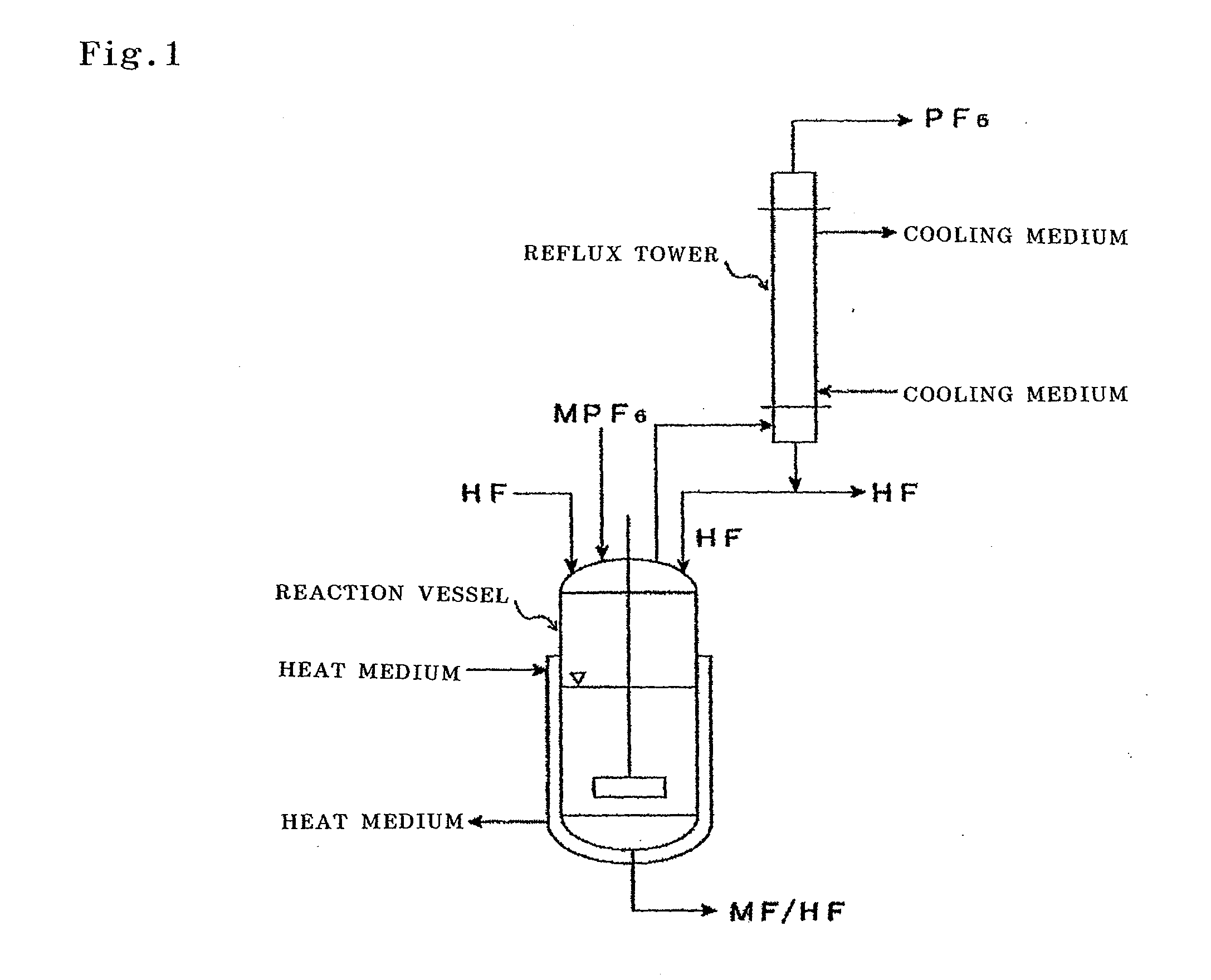Method of manufacturing phosphorous pentafluoride and hexafluorophosphate
a technology of phosphorous pentafluoride and hexafluorophosphate, which is applied in the direction of phosphorus halides/oxyhalides, chemistry apparatus and processes, inorganic chemistry, etc., can solve the problems of difficult decomposition of lipf, high cost of manufacturing, and high purity of pf/sub>5/sub>, etc., and achieves simple operation
- Summary
- Abstract
- Description
- Claims
- Application Information
AI Technical Summary
Benefits of technology
Problems solved by technology
Method used
Image
Examples
example 1
[0099]The following operations were performed using an apparatus shown in FIG. 1.
[0100]50 g of potassium hexafluorophosphate (KPF6) and 2000 g of anhydrous hydrogen fluoride (HF) from the market were placed in a 5 L reaction vessel made of a fluorine resin (PFA) together with a rotator, and the reaction vessel was connected to a reflux tower (20 mmφ×2 m) made of SUS 316. The PFA reaction vessel was warmed with a water bath so that the temperature outside the reaction vessel became 45° C., and at the same time, the reflux tower was cooled with a brine of −50° C. Furthermore, the reaction liquid was stirred with a magnetic stirrer. As the bath temperature increased, the reflux of HF started. The HF temperature inside at that time was 21° C.
[0101]After 5 minutes, a gas started to generate from the reflux tower. The analysis of this gas was performed with FTIR. As a result, it was confirmed that the gas was PF5 and a small amount of HF.
example 2
[0102]330 g of lithium hexafluorophosphate (LiPF6) and 2000 g of anhydrous HF were placed in a 5 L PFA reaction vessel together with a rotator, and the reaction vessel was connected to a reflux tower (20 mmφ×2 m) made of SUS 316. The PFA reaction vessel was warmed with a water bath to 80° C., and at the same time, the reflux tower was cooled with a brine of 0° C. Furthermore, the reaction liquid was stirred with a magnetic stirrer. As the bath temperature increased, the reflux of HF started. The HF temperature inside at that time was 30° C.
[0103]The analysis of the gas that was generated from the reflux tower was performed with FTIR, and it was confirmed that it was PF5 and a small amount of HF. At the same time, the generated gas was absorbed into pure water for 4 hours, and the P content of the absorption liquid was measured. As a result, the weight of the PF5 gas that was generated was calculated to be 205 g, and it was possible to generate 75% of the gas.
example 3
[0104]90 g of ammonium hexafluorophosphate (NH4PF6) and 2000 g of anhydrous HF were placed in a 5 L PFA reaction vessel together with a rotator, and the reaction liquid was stirred with a magnetic stirrer. Example 3 was performed without setting up the reflux tower. The generated gas was analyzed with FTIR, and at the same time, it was absorbed into pure water. When the PFA reaction vessel was warmed with a water bath to 65° C., hydrogen fluoride evaporated and reacted vigorously with pure water as the absorption liquid. When the FTIR analysis was performed on the generated gas, it was confirmed that the gas was PF5 and a large amount of HF. The gas was absorbed into pure water for 6 hours, and the P content of the absorption liquid was measured. As a result, the weight of the PF5 gas that was generated was calculated to be 43 g, and it was possible to generate 62% of the gas.
PUM
 Login to View More
Login to View More Abstract
Description
Claims
Application Information
 Login to View More
Login to View More - R&D
- Intellectual Property
- Life Sciences
- Materials
- Tech Scout
- Unparalleled Data Quality
- Higher Quality Content
- 60% Fewer Hallucinations
Browse by: Latest US Patents, China's latest patents, Technical Efficacy Thesaurus, Application Domain, Technology Topic, Popular Technical Reports.
© 2025 PatSnap. All rights reserved.Legal|Privacy policy|Modern Slavery Act Transparency Statement|Sitemap|About US| Contact US: help@patsnap.com


